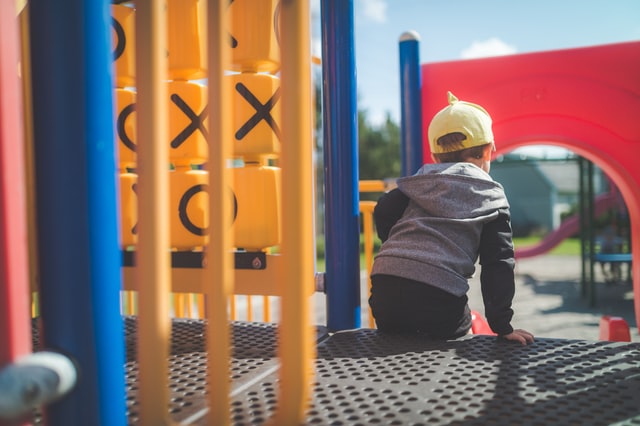You can’t always stop your children from getting scrapes and bruises. They’re clumsy, unpredictable and often seek out dangerous situations. However, you can make their playing environment safer for them and more manageable for yourself. Here are seven tips for keeping your kids safe at the playground.
Dress for the Occasion
Dress your kids appropriately for the weather and bring extra layers for all potential conditions. Your kids should stay cool and comfortable during playtime, but they also need protection from the elements. Pack a blanket, some jackets and an umbrella just in case.
The kids’ clothes should also be free of safety hazards. Avoid dresses, hoodies and other clothing articles with loose parts or drawstrings that might catch on a piece of equipment and lead to injuries. Open-toed shoes are also a bad idea. Dress your kids in light, breathable knock-around clothes and shoes with good traction.
Inspect the Playground
Before you let the kids play, inspect the playground to make sure it’s a safe place for them. Use the report card from the National Program for Playground Safety or create your own checklist based on your playground’s layout.
Check the equipment for excessive rust, loose parts and other potential hazards. Even the benches and picnic tables deserve an inspection. Everything should be in solid working condition. You don’t have to go somewhere else if one piece of equipment poses a threat, but you should make it off-limits to your kids.
You should pay especially close attention to the playground’s surface. Unsafe surfaces like asphalt and gravel are responsible for 75% of playground injuries. Grass, rubber and rubber mulch offer a soft cushion with minimal abrasion – the perfect playing surface for kids.
Regardless of the material, the surface might also have debris like broken glass and other hazardous materials that you need to remove. Lastly, check if the playground has safe and clean bathrooms nearby.
Ensure Proper Usage of Equipment
When you bring your kids to a playground for the first time, show them how to properly use each piece of equipment. You might feel silly climbing the monkey bars or going down all the slides, but they need to see demonstrations if you want them to do it right. Snuff out any unsafe activities, such as standing on the swings or sliding down head-first.
You should also set age limits for specific activities. Toddlers (one to two years) and preschoolers (two to five years) are too uncoordinated for complex tasks like climbing and jumping from elevated surfaces. They also might not weigh enough for certain pieces of equipment. Keep those age groups away from any areas of the playground you deem unsafe.
Keep the Kids Within Their Age Groups
Similarly, you should only let kids play within their age groups. Putting a five-year-old with a group of ten-year-olds increases the risk of an injury, as the kids have different physical capabilities. The five-year-old might get hurt during roughhousing or injure themself trying to keep up with the older kids. As such, they’re better off with other five-year-olds.
Youth sports leagues do the same thing. They establish age limits (and height/weight restrictions in special cases) to ensure that every kid is in a similar developmental stage and make the playing field as fair as possible. There’s a time and place for mixed-age playtime, but a physical environment like the playground isn’t one of them.
Teach Them How to Jump and Fall
You can’t stop kids from jumping and falling on playgrounds, so you’d might as well teach them how to do it right. Instruct them to practice these fundamentals:
Check to make sure no kids are in the way.
Jump feet-first and land with a slight bend in the knees.
If you fall, try to land on your buttocks for a softer impact.
We know it’s a little advanced for children, but discuss the tuck and role and other safe falling techniques with them. It could prevent concussions, fractures and other serious injuries if they fall from a tall piece of equipment.
Keep a Close Watch
It sounds self-explanatory, but you need to keep a close watch on your kids as they explore the playground. Even if they wear the right clothes, use equipment properly and play within their age groups, an accident can happen at any time. A quick reaction could make the difference between a minor and major injury.
Closely watching your kids during playtime also gives you greater insights about their behavior. You can study their interactions with other kids, see how they respond to obstacles and identify any negative habits that need addressing.
Bring a First Aid Kit
You don’t need to bring an entire ambulance, but a compact first aid kit for minor injuries will make your family’s playground time more enjoyable. You can patch up any cuts and scrapes, allowing your kids to get back to playing in just a few minutes. Plus, you have the resources to help other parents who need to tend to their children’s injuries.
Let Your Kids Thrive at the Playground
These seven tips enable your children to get the most out of their playground experience. Dress appropriately, make sure the playground is reliable, make sure the kids use the equipment as intended and separate them into age groups if necessary.
Most importantly, teach them how to play the right way. Show them how to jump, fall and navigate the playground safely. Supervise their actions and help them improve. If an accident happens (one usually does), you have a first aid kid to solve the problem. Playground safety isn’t about coddling your kids, but about letting them thrive.

